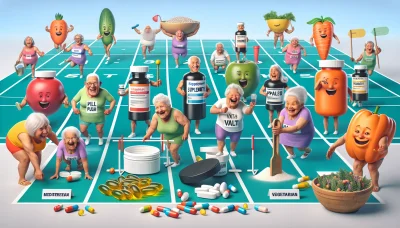Gluten free high fiber foods Quiz
Test Your Knowledge
Question of
Understanding Gluten-Free High Fiber Foods
What is Gluten and Why Go Gluten-Free?
Gluten is a protein found in wheat, barley, and rye, and for some individuals, it can cause health issues such as celiac disease or gluten sensitivity. Going gluten-free means eliminating these grains from your diet to avoid the discomfort or potential harm they can cause. This dietary change is essential for those diagnosed with celiac disease or non-celiac gluten sensitivity.
The decision to go gluten-free isn't just medical; some people choose this lifestyle for its perceived health benefits. These benefits include improved digestive health, increased energy levels, and a potential reduction in chronic inflammation. It's important to note that going gluten-free is a commitment and should be approached with careful consideration of nutritional needs.
Health Benefits of a Gluten-Free Diet
Adopting a gluten-free diet can lead to significant health improvements for those with gluten-related disorders. Symptoms like abdominal pain, bloating, and irregular bowel movements may diminish or disappear altogether. Moreover, the diet can prevent the damage to the small intestine that characterizes celiac disease, thus improving nutrient absorption.
Even for those without gluten sensitivities, a well-planned gluten-free diet can contribute to weight management and overall wellness. It encourages the consumption of whole foods and naturally gluten-free grains while reducing processed food intake, which can be beneficial for maintaining a healthy lifestyle.
Identifying Gluten in Foods
To successfully maintain a gluten-free diet, one must become adept at reading food labels. Gluten can lurk in unexpected places like sauces, dressings, and even certain medications. Always look for a gluten-free label or certification to ensure safety.
Becoming familiar with common sources of hidden gluten is crucial. Foods like soy sauce, malt vinegar, and beer often contain gluten unless specified otherwise. Cross-contamination is another concern, especially when dining out or purchasing bulk foods.
The Importance of Fiber in Your Diet
Fiber plays an integral role in digestive health by aiding bowel regularity and preventing constipation. A high-fiber diet has been linked to lower risks of heart disease, diabetes, and certain types of cancer. It's also pivotal in weight management as it helps you feel fuller for longer durations.
Despite its importance, many people do not consume enough fiber daily. This shortfall can lead to various health issues over time. Incorporating high-fiber foods into meals is an effective way to boost intake and promote overall well-being.
Types of Dietary Fiber
- *Soluble Fiber: Dissolves in water forming a gel-like substance; found in oats, legumes, nuts, apples. *Insoluble Fiber: Does not dissolve; adds bulk to stool; found in whole wheat flour, bran, nuts. *Resistant Starch: Not fully broken down; acts similarly to fiber; found in unripe bananas. *Prebiotic Fiber: Feeds beneficial gut bacteria; found in garlic, onions. *Functional Fiber: Extracted and added to food; includes supplements like psyllium husk.
Daily Recommended Fiber Intake
The daily recommended fiber intake varies by age and sex but generally ranges from 25 grams for adult women to 38 grams for adult men. Most people consume significantly less than this amountaveraging only about 15 grams per daywhich highlights the need for more conscious dietary choices.
Achieving adequate fiber intake requires deliberate incorporation of high-fiber foods into every meal. Simple swaps like choosing brown rice over white or adding beans to salads can make a noticeable difference in reaching these daily targets.
Top Gluten-Free High Fiber Foods to Include in Your Diet
Incorporating gluten-free high fiber foods into your diet doesn't have to be challenging. There are numerous delicious options that are both safe for those with gluten sensitivities and rich in dietary fiber. These include fruits vegetables legumes nuts seeds certain specialty grains.
Gluten-Free Whole Grains
Whole grains are a fantastic source of fiber and other nutrients while being naturally gluten-free. Quinoa buckwheat millet sorghum are excellent options that offer versatility culinary diversity alongside their health benefits.
High Fiber Fruits Vegetables
Fruits vegetables are packed with vitamins minerals antioxidants along with being high fiber champions Berries leafy greens broccoli artichokes all provide substantial amounts dietary fiber without any traces gluten making them essential components balanced diet.
Planning Your Gluten-Free High Fiber Diet
Creating a Balanced Gluten-Free Meal Plan
A balanced gluten-free high fiber diet is crucial for maintaining good health. Start by including a variety of fruits, vegetables, and gluten-free whole grains in your meals. Each meal should have a mix of carbohydrates, proteins, and fats to ensure you're getting all the necessary nutrients.
Integrating high fiber foods into your diet can be simple if you focus on natural, unprocessed foods. Beans, berries, and seeds like chia or flaxseeds are excellent sources of fiber and are naturally gluten-free. Remember to increase your fiber intake gradually to avoid digestive discomfort.
Sample Gluten-Free High Fiber Meal Ideas
For breakfast, consider a smoothie bowl topped with nuts and seeds or a quinoa porridge with fruit. Lunch could be a hearty salad with chickpeas and an array of colorful veggies. For dinner, brown rice pasta with a vegetable-based sauce is both satisfying and fiber-rich.
Snacks are an opportunity to boost your fiber intake as well. Opt for fresh fruit, vegetable sticks with hummus, or homemade popcorn (without additives) for a midday energy lift that aligns with your dietary needs.
Tips for Meal Prepping and Grocery Shopping
- Read Labels: Always check product labels for hidden gluten and fiber content.
- Bulk Cooking: Prepare large quantities of staple dishes like soups or stews that can be easily reheated throughout the week.
- Shop the Perimeter: The outer aisles of the grocery store typically contain the freshest gluten-free produce and proteins.
- Fresh Over Packaged: Whenever possible, choose fresh foods over packaged ones to avoid hidden gluten and additives while maximizing fiber intake.
- Variety is Key: Incorporate different fruits and vegetables each week to keep meals interesting and nutritionally diverse.
Understanding Food Labels and Ingredients
Navigating food labels is essential when following a gluten-free high fiber diet. Learn to identify terms that indicate the presence of gluten, such as wheat, barley, rye, malt, brewer's yeast, and oats (unless certified gluten-free).
The ingredient list is your best source for determining both the gluten content and the nutritional value of food. Look beyond just "fiber" on the label; also assess the types of ingredients used to ensure they align with your dietary goals.
How to Spot Hidden Gluten
Hidden gluten can lurk in sauces, dressings, and even soups. Be vigilant about ingredients like modified food starch or dextrin which can be derived from wheat. When in doubt about an ingredient's source, contact the manufacturer for clarification.
Cross-contamination is another concern for those with celiac disease or severe gluten sensitivity. Products labeled as "gluten-free" must meet strict standards but always double-check manufacturing practices if you're highly sensitive.
Finding Fiber Content Information
To find fiber content information, look at the nutrition facts label under "Dietary Fiber." This will tell you how many grams of fiber are in each serving of the product. Compare this number across similar products to choose the one with higher fiber content.
Besides packaged goods, familiarize yourself with the natural fiber content of whole foods such as fruits, vegetables, legumes, nuts, and seeds so you can make informed choices without always needing a label.
Navigating Social Situations and Dining Out
Social situations require planning ahead when you're on a specialized diet. Inform hosts of your dietary restrictions in advance or offer to bring a dish that meets your needs. This ensures you'll have something safe to eat without putting pressure on your host.
In professional settings or events where you cannot control the menu options available, eating beforehand or bringing suitable snacks can help manage hunger without compromising your diet.
Communicating Dietary Restrictions
Clear communication about your dietary restrictions is key when dining out or attending social gatherings. Don't hesitate to ask questions about menu items and their preparation methods to ensure they are safe for you to eat.
Gluten-Free High Fiber Recipes for Every Meal
Breakfast Ideas to Kickstart Your Day
Begin your day with energy and gusto! A gluten-free breakfast that's packed with fiber sets the tone for a productive day. From warm oatmeal alternatives to innovative quinoa creations, these options are not only nutritious but also incredibly satisfying.
Mornings can be hectic, but that doesn't mean you have to compromise on health. Whip up a batch of gluten-free muffins or pancakes during the weekend, and enjoy a quick, fibrous breakfast throughout the week. Trust me, your body will thank you!
High Fiber Gluten-Free Cereal Options
Who said cereal had to be off-limits? Dive into a bowl of gluten-free high fiber cereals made from seeds like chia, flaxseed, or buckwheat. Sprinkle in some nuts and fresh fruit, and you've got yourself a champion's breakfast!
Cereals don't have to be sugar-laden enemies of health. With gluten-free grains such as millet or amaranth, you can create your own granola mix. It's perfect for those who are always on the go!
Quick and Easy Smoothie Recipes
Smoothies are the ultimate fast food for health enthusiasts. Blend dark leafy greens like spinach or kale with gluten-free fibers like avocado or berries for a quick nutritional blast. Add a scoop of gluten-free protein powder for an extra boost!
Transform your smoothie into a fiber powerhouse with seeds such as chia or flaxseeds. These tiny additions not only thicken your drink but also provide an essential dose of omega-3 fatty acids. Delicious and beneficial its a win-win!
Satisfying Lunches That Pack a Fiber Punch
Lunch is your mid-day fuel, so make it count with gluten-free choices brimming with fiber! Salads don't have to be dull; mix in crunchy nuts and seeds, fresh veggies, and satisfying grains like quinoa to keep you full until dinner.
Your desk lunch doesn't have to be dreary or repetitive. Explore the world of gluten-free wraps using ingredients like lettuce leaves or corn tortillas filled with an array of veggies, beans, and lean proteins all high in fiber and flavor!
Hearty Salads with a Variety of Textures
A salad can be more than just lettuce! Create texture-rich bowls by adding roasted vegetables, cooked beans, and seeds like pumpkin or sunflower. Dress it up with a zesty vinaigrette for an explosion of taste in every bite.
- Mix different colored vegetables for a nutrient-dense meal.
- Incorporate protein sources like chickpeas or lentils.
- Top with nuts or seeds for added crunch and fiber.
- Experiment with dressings made from tahini or avocado for healthy fats.
Gluten-Free Sandwiches and Wraps Alternatives
Sandwiches are back on the menu! Gluten-free bread has come a long way; choose from options made with almond flour or teff for that perfect sandwich experience without the wheat.
If you're looking to change things up, why not try a wrap? Use large collard green leaves as a nutrient-rich substitute for traditional tortillas. Fill them up with grilled veggies and hummus for an unforgettable lunchtime treat.
Delicious Dinners to End Your Day Right
Dinner is your time to unwind and nourish your body after a long day. Gluten-free pasta made from legumes offers both comfort and nutrition while delivering that much-needed dietary fiber.
Casseroles arent just convenient; theyre also perfect for packing in fiber-rich vegetables and gluten-free grains. Layer in sweet potatoes, quinoa, and black beans for a satisfying end-of-day meal that'll leave you feeling good inside out.
Gluten-Free Pasta and Rice Dishes
The pasta possibilities are endless when you go gluten-free! Brown rice pasta paired with hearty vegetables like broccoli or Brussels sprouts makes for an irresistible combo that satisfies both your taste buds and nutritional needs.
Rice dishes offer comfort in every spoonful. Stir-fry brown rice with colorful peppers, onions, and snap peas; add tofu or chicken strips for protein its simple yet so rich in flavors and fibers!
Fiber-Rich Stews and Casseroles
A stew can be both heartwarming and health-boosting. Simmer lentils or chickpeas with tomatoes, carrots, and kale for an easy dish that's brimming with vitamins, minerals, and fibers - it's soul food that loves you back!
Casseroles are the ultimate one-dish wonders mix in various beans, root vegetables, and even fruits like apples for added sweetness. Bake until bubbly perfection is achieved; each bite is loaded with nutrients that support your well-being!
Managing Health Conditions with a Gluten-Free High Fiber Diet
Celiac Disease and Non-Celiac Gluten Sensitivity
Individuals diagnosed with Celiac disease must avoid gluten to prevent serious health complications. This autoimmune disorder triggers an adverse reaction to gluten, leading to damage in the small intestine. Non-Celiac Gluten Sensitivity (NCGS) also necessitates a strict gluten-free diet, although it doesn't cause the same intestinal damage as Celiac disease. Both conditions can be effectively managed by eliminating gluten from one's diet.
Living gluten-free is critical for maintaining the well-being of those affected by Celiac or NCGS. Steering clear of wheat, barley, and rye is non-negotiable. However, it's equally important to ensure that the diet is balanced and nutritious. Many gluten-free products lack fiber, so it is vital to find alternative sources to maintain digestive health.
The Role of Gluten-Free Diets in Managing Symptoms
Avoiding gluten is not only a lifestyle choice but a necessity for people with Celiac disease and NCGS. By following a strict gluten-free diet, patients can alleviate symptoms such as abdominal pain, bloating, and fatigue. It's crucial to adhere to this dietary regimen consistently, as even small amounts of gluten can cause significant discomfort and health setbacks for those sensitive.
Incorporating High Fiber Foods for Digestive Health
Fiber plays a pivotal role in digestive health, particularly for individuals on a gluten-free diet. Consuming high fiber foods like fruits, vegetables, legumes, and certain grains like quinoa can help maintain regular bowel movements and prevent constipationa common concern among those following a gluten-free lifestyle. It's essential to integrate these high fiber foods into daily meals for optimal digestive function.
Weight Management and Metabolic Health
High fiber foods are instrumental in weight management strategies due to their ability to increase satiety and reduce overall calorie intake. Foods rich in fiber take longer to chew and digest, leading to a slower rise in blood sugar levels and prolonged feelings of fullness. This can significantly aid in controlling appetite and managing weight effectively.
How High Fiber Foods Can Aid in Weight Loss
Incorporating high fiber foods into your diet can be a game-changer for weight loss. They not only help control hunger but also contribute positively to gut health. A high-fiber diet supports beneficial gut bacteria which play a role in metabolism and weight regulation. Selecting naturally fibrous foods over processed options will maximize these benefits.
The Impact of a Gluten-Free Diet on Metabolism
A gluten-free diet can impact metabolic health positively when done correctly. By replacing refined gluten-containing products with nutrient-dense alternatives such as beans, nuts, seeds, fruits, and vegetables, you enhance your body's metabolic processes. It's important to note that simply going gluten-free is not inherently healthier; it's the quality of the dietary choices that matter most.
- *Enumerative Lists: Used for itemizing elements, events, or tasks. *Descriptive Lists: Each item is accompanied by additional details. *Checklists: Designed for tracking completion or presence of items. *Multilevel Lists: Nested lists with items having sub-items. *Matrix Lists: Information presented in two-dimensional grids. *Priority Lists: Organized based on importance or urgency. *Comparative Lists: Juxtaposing items to highlight differences.
Heart Health and Diabetes Control
A high fiber intake has been linked to improved heart health due to its cholesterol-lowering effects. Soluble fibers found in oats, nuts, seeds, and legumes bind cholesterol in the digestive system and aid its removal from the body. This process helps reduce overall cholesterol levels and lowers the risk of heart disease.
The Connection Between Fiber Intake and Heart Health
Eating plenty of fiber-rich foods contributes significantly to cardiovascular health. The consumption of dietary fiber has been associated with reduced blood pressure and inflammationtwo critical factors in preventing heart disease. Ensuring an adequate intake of high-fiber foods supports long-term heart health.
Balancing Blood Sugar with a High Fiber Diet
A high fiber diet is beneficial for individuals managing diabetes as it helps regulate blood sugar levels. Fiber slows down the absorption of sugar during digestion, preventing spikes in blood glucose levels after meals. For effective diabetes control, integrating high-fiber foods into every meal is essential.
Overcoming Challenges of a Gluten-Free High Fiber Diet
Dealing with Limited Food Choices
Transitioning to a gluten-free, high-fiber diet can initially feel restrictive. Many staple foods like bread, cereals, and pasta may suddenly be off-limits. However, this limitation is an opportunity to explore a wide array of unprocessed foods such as fruits, vegetables, and legumes that are naturally gluten-free and rich in fiber.
Finding tasty and nutritious options requires creativity and willingness to try new things. Gluten-free grains like quinoa, buckwheat, and millet are not only high in fiber but also offer a variety of flavors and textures to keep meals interesting. Experimenting with these can open up a whole new world of culinary delights!
Expanding Your Food Horizons with New Ingredients
Diving into the world of gluten-free ingredients can transform your diet from monotonous to exciting. There's a treasure trove of lesser-known grains such as amaranth, teff, and sorghum that are both gluten-free and high in fiber. By incorporating these into your meals, you can enjoy a diverse and satisfying diet.
Additionally, nuts and seeds are powerhouses of nutrition and can add crunch and flavor to any dish. Chia seeds, flaxseeds, almonds, and walnuts not only boost fiber intake but also provide healthy fats essential for optimal health. Don't hesitate to sprinkle them over salads or blend them into smoothies!
Finding Substitutes for Common High-Fiber Gluten Foods
- Bread: Opt for gluten-free bread made from almond flour or coconut flour which are both high in dietary fiber.
- Pasta: Try pasta alternatives like spaghetti squash or noodles made from beans or lentils.
- Cereals: Look for cereals that are labeled gluten-free and contain high-fiber ingredients like buckwheat or brown rice.
- Baked Goods: Use gluten-free whole grain flours such as oat flour or chickpea flour for homemade baked goods.
- Snacks: Choose snacks like popcorn (ensure it's uncontaminated by gluten), rice cakes topped with avocado, or homemade trail mix.
Ensuring Nutritional Adequacy Without Gluten
A major concern when following a gluten-free diet is missing out on essential nutrients commonly found in wheat-based products. To address this challenge, focus on whole foods that are naturally rich in vitamins and minerals. Fresh fruits and vegetables should become staples in your pantry for their nutrient density and fiber content.
It's also crucial to vary your protein sources. Include beans, lentils, fish, lean meats, and dairy (if tolerated) to get a broad spectrum of nutrients. These foods will help maintain muscle mass and support overall health while providing necessary dietary fiber.
Meeting Your Nutritional Needs with Supplements
In some cases, supplements may be needed to meet your daily nutritional requirements on a gluten-free diet. Consult with a healthcare professional before starting any supplement regimen to ensure it complements your dietary needs without causing harm or nutrient imbalances.
Vitamins like B complex, D, iron, calcium, and magnesium might be necessary depending on individual health profiles. Remember that supplements should not replace whole foods but rather act as an insurance policy alongside a well-rounded diet.
Diverse Sources of Essential Nutrients in a Gluten-Free Diet
Achieving nutritional adequacy on a gluten-free diet goes beyond just removing gluten; it involves strategic food choices. Fortified gluten-free products can be useful sources of B vitamins and iron which are often lacking in this diet type.
To ensure you're getting enough omega-3 fatty acids without the whole grains typically recommended for heart health, turn to fatty fish like salmon or plant-based sources such as flaxseed oil or walnuts. It's all about finding balance within the constraints of your dietary needs!
Staying Motivated and Committed to Your Diet
Maintaining motivation for any diet change is challenging but crucial for long-term success. Setting small achievable goals helps create momentumcelebrate every time you find a new favorite recipe or when you've successfully avoided gluten for another week!
An effective way to stay on track is by tracking progress through food journals or apps designed for dietary management. Visualizing what you eat can empower you to make healthier choices consistently.
Setting Realistic Goals and Tracking Progress
Create realistic expectations from the outset; understand that slip-ups happen but they don't define your journey towards better health. Establish clear objectives like incorporating one new high-fiber food per week or cooking two new gluten-free recipes monthly. These goals provide direction without overwhelming you.
Tracking progress is not just about maintaining accountability; it serves as an invaluable tool for reflection on how far you've come. Regularly look back at your accomplishmentsthis practice reinforces positive eating habits and strengthens commitment.
Building a Support System and Community
Nobody should have to navigate dietary changes alone! Establishing a support network is key; connect with others who follow similar diets through online forums or local groups where experiences can be shared. This camaraderie fosters learning from each other's successes and challenges.
Leverage the expertise of nutritionists or dieticians who specialize in gluten-free livingthey're invaluable resources for meal planning advice tailored specifically to your needs! Also remember: friends & family want you to succeed; involve them in the journey by sharing recipes or cooking together!
Advancements in Gluten-Free High Fiber Food Products
The Evolution of Gluten-Free Food Options
Gluten-free products have undergone a revolutionary transformation, evolving from scarce and bland options to a plethora of delicious and nutritious choices. The early days of gluten-free eating were marked by limited availability and often unpalatable alternatives. However, today's market showcases an array of products that cater to the gluten-sensitive without compromising on taste or variety.
Manufacturers have harnessed innovative food technology to recreate the texture and flavor profiles of traditional gluten-containing foods. This progress has enabled those with celiac disease or gluten intolerance to enjoy comparable versions of their favorite foods. From pasta and bread to cookies and cakes, the expansion of gluten-free options is truly remarkable.
How Food Technology is Changing the Game
Food technology has been pivotal in advancing gluten-free high fiber food options. Scientists and nutritionists are collaborating to develop new methods for enhancing texture and nutritional value. The use of alternative flours, such as almond or coconut flour, along with binders like xanthan gum, has improved both taste and structural integrity.
Innovations in processing have also allowed for increased fiber content without affecting the desirable qualities of foods. Techniques such as extrusion cooking are being utilized to incorporate high fiber ingredients while maintaining an enjoyable eating experience. These advancements underscore the role of food technology in revolutionizing gluten-free diets.
The Rise of Gluten-Free Alternatives in Supermarkets
The presence of gluten-free alternatives in supermarkets has soared, reflecting growing consumer demand. Shelves that were once sparsely populated with gluten-free items now overflow with a rich diversity of products. Supermarkets are dedicating entire sections to these alternatives, making them more accessible than ever before.
Increased competition among brands is driving innovation and quality upwards while pushing prices down. Consumers benefit from this competitive market through better-tasting, higher-quality, and more affordable gluten-free choices. This proliferation also represents a broader societal shift towards inclusive food offerings catering to diverse dietary needs.
Reviewing the Latest High Fiber Gluten-Free Snacks and Bars
The latest high fiber gluten-free snacks and bars are setting new standards for healthful indulgence. These products not only satisfy dietary restrictions but also contribute positively to overall gut health thanks to their high fiber content. Brands are now emphasizing both the absence of gluten and the inclusion of beneficial nutrients like fiber.
Evaluating Nutritional Content and Ingredients
- *Check ingredient labels for whole-food sources. *Verify fiber content per serving. *Look for added sugars or artificial sweeteners. *Consider any additional dietary benefits such as protein or essential vitamins.
Taste Testing and Consumer Reviews
Taste testing plays a crucial role in determining the success of these innovative snacks and bars. The best products strike a balance between health benefits and palatability. Consumer reviews often highlight this balance as a deciding factor in their purchasing decisions.
Consumer feedback has become invaluable for manufacturers aiming to refine their recipes. The insights gained from reviews guide improvements and can lead to the development of new flavors or formulations that align more closely with consumer preferences.
The Future of Gluten-Free High Fiber Foods
The future looks bright for gluten-free high fiber foods as trends indicate continued growth in health consciousness among consumers. As people become more aware of the importance of dietary fiber, demand for enriched gluten-free options is expected to rise.
Upcoming Trends in Health Foods
Upcoming trends suggest an even greater emphasis on natural ingredients and clean labels, with consumers seeking transparency about what they eat. Functional foods that offer additional health benefits beyond basic nutrition are becoming particularly popular within the gluten-free sector.
Innovations in Food Processing and Availability
Innovations in food processing promise to make high fiber gluten-free foods more widely available than ever before. Breakthroughs in production techniques will likely lead to enhanced textures and flavors that closely mimic those found in traditional foods.












